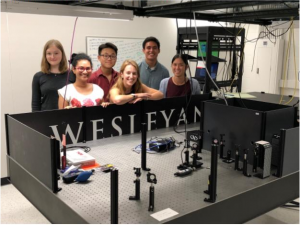
The research explored here, “Spectroscopic Studies of Hybrid Perovskite Solar Cells,” was undertaken as part of the College of the Environment’s Faculty-Student Research Grant Program, which provides opportunities for faculty and students to work together on research projects.
Meng-ju Renee Sher ’07 is assistant professor of physics, assistant professor of integrative sciences, and assistant professor of environmental studies at Wesleyan University. Sher received her bachelor’s degree from Wesleyan in 2007 and PhD degree from Harvard University in 2013.
Professor Sher’s research group is focused on understanding the underlying physics of energy materials and guiding future renewable energy development. The Sher Group studies charge carrier motions in solids, with an interest in optoelectronic properties of renewable energy materials, and uses techniques such as time-resolved terahertz spectroscopy to study “the ultrafast charge carrier generation and transport dynamics.”
Tell us about the research you undertook as part of the COE’s Faculty-Student Research Grant Program.
Renee Sher: Silicon solar cells have reached near the theoretical maximum efficiency, and the next efficiency improvement requires a different cell architecture. Hybrid perovskites represent a very promising material for forming a tandem cell with silicon. By incorporating different organic molecules, optical properties of these perovskites can be widely tuned, and the electronic transport quality can be made comparable to inorganic crystals. The Sher Group uses ultrafast lasers to study both silicon and perovskite materials. We study the flow of electrons in the moments after a solar cell absorbs light and investigate how conductive properties change with different material composition. Additionally, we seek to study in detail light emission characteristics and other relevant optical properties of emerging solar cell materials.
What kinds of students get involved with your research, and with what level of experience?
RS: It’s never too late or too early to get involved with research; my lab has a healthy balance of freshmen through seniors. While most of my students are physics majors, that is not a requirement. I often have students who are interested in energy technology contacting me or meeting me at seminars I give on campus.
What was the purpose of the project? What did you hope to find?
RS: The purpose of the project is to study electron dynamics in a new type of solar cell. Organic-inorganic hybrid perovskite is a funny crystal where organic molecules are periodically arranged with inorganic atoms and form a crystal. Within a decade of discovering these materials, the solar cell conversion efficiency is approaching conventional silicon solar cells. The benefit of hybrid perovskite is that it is very easy to make and the properties can be widely tuned. The downside, however, is their stability against environmental factors such as heat, moisture, and even presence of oxygen. In some hybrid perovskite compositions, the material is more stable but the electronic conduction properties are poor. We use ultrafast lasers in our lab to investigate electron transport properties. In particular, we ask how long these electrons stay excited after absorbing sunlight. How fast do they move around? We hope to find ways to improve material development through fundamental understanding of electron transport in these materials.
Tell us what you found and present about at the conferences you attended. Where there any surprises?
RS: My team members presented their research results at conferences organized by the American Physical Society and the Materials Research Society. Polly Pierone and Tony Liu presented their work at the American Physical Society’s annual March meeting last month. Polly presented a poster where we systematically vary the composition of the perovskite material. When a larger molecule is substituted into the material, the material is more stable but electrons’ mobility reduces dramatically. One thing we did not expect is that while electron mobility is reduced, electron lifetime becomes longer. Both parameters are crucial for extracting energetic electrons from a solar cell.Our finding suggests that there could be a sweet spot where the balance of lifetime and mobility is most beneficial for solar cell applications.
Tony Liu presented a poster on a different topic: He is currently building an optical characterization system to examine a material’s optical properties at various temperatures. The material he is currently testing is not a perovskite material, but the hybrid perovskite material has many phase transitions within the temperature range we can reach.We look forward to probing these materials’ optical property not just for solar cell but possibly other optoelectronic applications.
Senali Dissanayake, Rhoen Fiutak, and Matt Erodici presented their research last November at the Materials Research Society’s annual fall meeting.
One highlight from the conference was that we all went to a talk given by two of the 2018 Nobel Prize for Physics laureates—Donna Strickland and Gerard Mourou. The two invented the technique that is used to produce the ultrafast laser pulses we use every day in our lab.
What are your next steps with this project?
RS: The material parameter space is big. When different types of organic molecules or inorganic atoms are used to make hybrid-perovskite, the crystal structure can vary widely. For example, the material could be a 3D crystal, 2D sheets, or even 1D or 0D material. Currently we are ramping up characterization capabilities in our lab and at the same time working with collaborators on material synthesis.
From left, in photo above: Polly Pierone ’20, grad student Senali Dissanayake, Tony Jianbang Liu ’20, Rhoen Fiutak ’19, Matthew Erodici ’19 and M.-J. Renee Sher, assistant professor of physics.